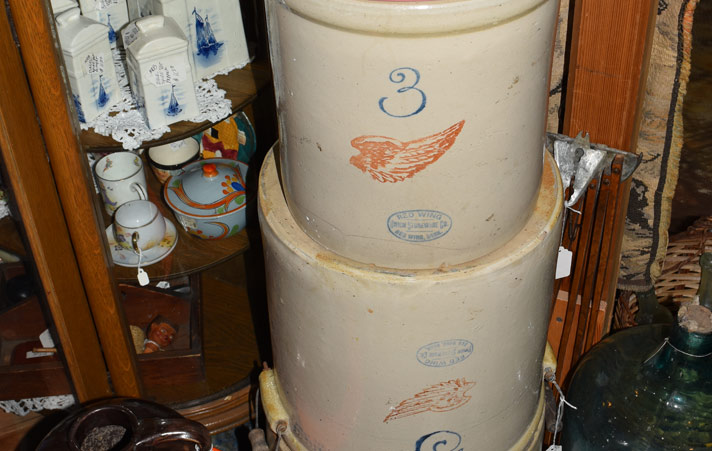Speaking of Antiquing – March 2017
In the 1860’s, German immigrants settled along the Mississippi River in a town called Red Wing, Minnesota. Fortune smiled on them, as they were skilled potters and the clay soil was perfect for producing stoneware crocks, jugs, pottery for food storage, and other household items.
By 1877, Red Wing Stoneware Co. was producing hand-turned, salt-glazed butter churns, water coolers, and other products, using primitive hand-painted designs and pressed-in handles.
By the arrival of the 1900’s, production had boomed, and Red Wing was the largest stoneware producer in America. The age of the assembly line boosted production to fill demand. Items were turned on multiple rows of motorized wheels and decorated in a different area by a different person entirely. Gone was the era of one person seeing an item made from start to finish.
Glaze changed in this era also, giving food service items a more uniform coating and a more “finished” appearance. The glaze known as “Bristol glaze,” or “zinc glaze,” gave the items a neutral background for their now-famous Red Wing logo.
In 1915, Red Wing acquired a patent for their method of affixing wire handles on their heaviest items. These handles and patent stamps were used until Red Wing stopped making stoneware in 1947. Red Wing produced roughly 2000 styles of art pottery between 1929 and their closing in 1967.
An important note for the Red Wing collector is that other companies merged with Red Wing. Items from the merging companies were marked with both company names, each retaining their identity, specifically Minnesota Stoneware Co. from 1883 to 1906; North Star Stoneware Co. from 1892 to 1896; Union Stoneware Co. from 1894 to 1906.
Red Wing products were shipped by rail to most of the United States and Canada. Many large or small companies purchasing from Red Wing requested that their company’s logo and name be added to the pottery, thus creating a huge variety of advertising collectibles.
Quality to the investor is the factor that gives an item its maximum worth. Condition is only one aspect that a collector will consider when buying. Condition will not be as important as rarity and desirability. If a piece is rare, such as the early salt glaze pieces, or specific-area advertising pieces, then condition is not as important and certain flaws can be overlooked. A degree in rarity will boost prices astronomically. More common art pottery pieces made in the latter years of Red Wings’ 90 years of production will fetch lower prices due to availability.
It will be almost impossible to collect everything that Red Wing produced, so specify what you like and what you can afford. If you see something in the places you haunt that you haven’t seen before, best to snatch it up!

 Margaret Barns is co-owner of Pickety Place Antiques & Collectibles located at 130 N. 4th Street in Jacksonville. LIKE them on
Margaret Barns is co-owner of Pickety Place Antiques & Collectibles located at 130 N. 4th Street in Jacksonville. LIKE them on